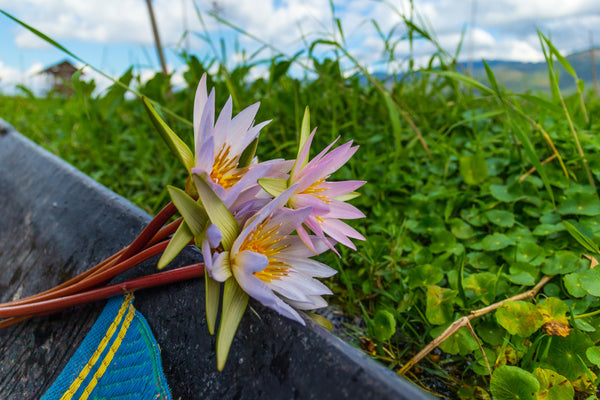Know Your Fiber: Lotus Fiber
Posted on October 01 2022

Folks have made use of a wide variety of plant fibers for spinning throughout history. While flax, cotton, and hemp are among the best known of plants fibers, there are many, many other plant fibers that are spun for cord and clothing. Lotus fiber, also known as lotus silk, is one of the rarer plant fibers.
Modern production of lotus fiber is centered in Myanmar, Vietnam, and some parts of India. However, using the bast fibers of lotus stems for spinning and weaving has its historic origin in Myanmar. According to some Buddhist teachings, the first lotus robes appeared within five flower buds on a lotus plant, along with the prophecy that there was one for each Buddha that would arrive in the world. Four have already been offered, leaving just one lotus robe left to give to a future Buddha.
While it does seem likely that first discovery of lotus fiber preceded the modern era, it turns out that the first recorded production of lotus fiber is relatively recent. Sar Oo, an Intha woman from the early 20th century living in what is today Myanmar, is thought to be the first to make lotus silk. Sar Oo was well known as a skilled spinner and weaver and when she was around 50 years old she decided to give lotus fiber a try.
Lotuses of varying species are found in many lakes and ponds throughout that region of Asia, and the roots and seeds are a common food. Sar Oo no doubt had ample opportunity throughout her life to notice the long bast fibers contained in the stems and ponder whether or not they could be made into fabric. When she did begin to test her theory, she found that the resulting fibers and spun thread was as soft as silk.
Sar Oo’s first finished lotus silk project was a traditional Buddhist monk’s robe known as a kya thingahn. She gifted this finished robe to the senior monk of the nearest monastery. Sar Oo ended up making much of her income throughout the rest of her life by making these lotus silk robes. Only a few people in her family besides Sar Oo knew how to create and spin lotus silk, and so after her death the art almost became extinct. Fortunately, her family members revived the art, eventually creating a cooperative to produce traditional lotus silk fabric.
Hand-harvested, hand spun, and hand-woven lotus silk has become a profitable cottage industry today in both Myanmar and in Vietnam. Monks’ robes are still made from lotus silk, and scarves and stoles are made as luxury items for the public. It takes a very long time to harvest and create lotus fiber by hand, especially since around 10 or so lotus stems are needed to produce a yard of finely spun thread. However, many different species of lotuses can be utilized for lotus silk, making it an abundant resource.
Traditionally, the thread itself is made by gently cutting through the outer part of a prepared lotus stem, pulling the two ends gently to release the bast fibers, and twisting the two stem ends during the extraction to produce a spun thread. While this produces a beautiful thread, it is very time consuming. As lotus silk became better known throughout the world, it created greater demand for lotus silk fabric. The level of commercial demand simply could not be met by the skilled handcrafters of traditional lotus silk. So, people in the textile industry set their minds to coming up with ways to produce greater amounts of lotus fiber that could be used for mechanical manufacturing.
There are a few ways to do this. One method is to microwave the stems with a bit of hydrogen peroxide. Once treated, the bast fibers can be removed and are ready for machine or hand spinning. Other lotus fiber is produced in the same way as modal or viscose, by treating the dried lotus stems with chemicals to create a cellulose product that can be extruded into fiber – much of the lotus fiber in North America is from this production method. Regardless of its method of production, though, working lotus fiber is delicate work. For commercial production, only looms that can spin or weave silk can handle lotus fiber, and as lotus fiber can be finer than some silks there can be more issues with breakage. In some folks’ opinion, hand-spinning remains the best way to work with even non-traditionally produced lotus fiber.
Lotus silk has only been available to the fiber artists and crafters in North America for a few years now. The micron width of the fibers can be as low as 5 microns, but the staple length is quite long. Spinning an even thread can be quite challenging for even experienced spinners, though, and so some spinners like to blend it with other fibers such as wool or even cotton. Like other plant fibers, lotus fiber is a renewable resource. However, unlike plant fibers like linen and cotton that require heavy fertilizing and irrigation, lotus growing requires little more than the already existing ponds and lakes of its home regions. Ready to try some out? We have lotus fiber available several times a year depending on seasonal availability. Buy a few ounces and check out this luxury fiber for yourself!


Follow US